Fiber Identification from Ethiopian Ladies Skirt- Juniper Publishers
Journal of Fashion Technology- Juniper publishers
Abstract
Along with the trend toward automation in the textile
industry, an objective, correct, and efficient fiber identification
method and blend analysis has become an important component of rapid
respondent systems the textile industry desires. This research is doing
component and percentage quantity analysis for fabrics imported to
Ethiopia at present situation for ladies skirts. Identification and
analysis is done by assessing fiber hand touch feeling characteristics,
burning nature, longitudinal microscopic appearance, solubility in many
chemical solvents and blend ratio analysis calculation. Most of the
fabrics imported to Ethiopia for ladies skirt are synthetics and blend
of synthetics like polyester, acrylic ,blend of polyester and wool,
blend of polyester and cotton, blend of polyester, cotton and wool,
blend of polyester, acrylic and wool, blend of polyester and acrylic,
blend of polyester and nylon ,blend of polyester ,nylon and cotton.
Polyester is the major of which imported in single component and blended
with others. Some fabrics contain Lycra spandexes which give better
stretch ability. Considering the comfort, cost effectiveness and
serviceability blend of polyesters with natural are highly desired by
Ethiopian ladies. Therefore it is advantageous to produce these kinds of
fabrics the country for the future to satisfy the Ethiopian ladies
need.
Keywords: Fiber identification, Blend analysis, Ladies skirts, Solubility, Longitudinal microscopic appearance
Introduction
Nowadays wearing skirt is becoming a fashion and many
styles of skirt are introduced. Ethiopian ladies wear skirts more than
other country ladies. This shows that our country imports many finished
fabrics which have different characteristics, services and costs. The
style of the skirts can be made during sewing i.e. garment formation,
finishing types given during wet processing, weaving mechanism and the
type of the fiber/s used. To identify and analyze any type of skirt from
which fiber/s is made, the study of textile fibers has become a very
interesting and challenging science. This study is related to their
identification methods and blend analysis techniques of the type/s of
the fiber/s. The textile fiber products Identification Act requires that
the manufacturers of cloth garments and household textiles attach
labels to their products specifying the fiber content. These
manufacturers are expected to know this information since it is they who
tell the fabric producers the requirements for the fabrics they
intended to purchase. Should product manufacturers to identify or verify
the fiber content; they must be in a position either to make the
appropriate technical analysis or refer samples to a testing laboratory [1].
The retailer, in turn, is held responsible under the
act to see that labels or hangtags are attached to the textile products
before being sold. Reliance must be placed on the retailer's vendor to
provide properly labeled merchandise. Sometimes imported merchandise
arrives unlabeled or sometimes labels become detached and lost. It is
then the merchant's responsibility to get appropriate labels and to
attach them to the merchandise [2].
Ready recognition and identification of fiber content
in fabrics has become extremely difficult even for knowledgeable and
experienced merchants because of the growing variety of types of fibers,
the blending techniques in yarn and fabric construction and the
finishes that affect the appearance and hand of the fabrics. Therefore,
certain laboratory tests are used for identification and verification [2].
The consumer has the greatest difficulty in
identifying fiber content of fabrics. Should the identification and/or
care labels be mutilated or lost from textile product, one may not know
the composition of the fabric and therefore not know what to expect of
it. Because one is usually not in a position to make a laboratory
analysis, reliance must be placed up on certain nontechnical tests. A
dye house or a dyeing enterprise should have a well qualified or shelled
technical to identify the composition or fiber type supplied before
processing. This is important to prepare the right recipe (formulation)
and select suitable dye, machinery and processing [2].
Garment industry, custom, quality and standardization
authorities and ministry of revenue should have a well qualified
technique to identify the fiber type supplied from any country to
control the quality and to confirm the customer requirements. Fabrics
imported to our country have to be identified and analyzed their quality
and percentage quantity composition, since it is necessary to decide
the quality and cost of the fabrics based on their type and component.
Materials and Methods
Materials
a. Finished fabrics: Different types of finished
fabrics of different weight, composition, surface character, color, with
no specified ratio of different blends in their labels.
b. Chemicals: Sulphuric acid (998% BDH), hydrochloric
acid (36%BDH), glacial acetic acid (BDH), formic acid(BDH), nitric acid
(69-72% BSSEX England), sodium hydroxide(Pellets) and acetone (EEC).
c. Equipments and Apparatus: Different equipments,
which are found in the wet processing and fiber-testing laboratory, have
been used.
4.2. Methods
The experiment must do stepwise to save time,
material and cost. Thus as we have done our experiment the steps to
reduce these things are as follow below respective.
a. Feeling test: By handling both sides of the fabric
gently in three rounds, stretching the fabric holding with our hand and
observing the coolness/warmness, smoothness, softness and elasticity of
each fabrics.
b. Burning test: By holding the individual fabric
samples to be tested in our hand and bring the fabric slowly to the side
of a candle burner flame and withdrawing it. We have observed the
initial reaction of the fabric and the flame, flame description, odour,
extinguishable nature and residue of the burned fabric.
c. Microscopic test (longitudinal): By separating the
yarns into fibers we have put the fibers into watch glass or slider,
and then to the sample place and viewing the longitudinal appearance.
d. Solubility Test: By taking a piece of warps and
wefts having 1gm each from each fabric as a sample we put into the
solutions and stirring occasionally. By removing what is left into a
beaker of water with care we have stirred once more, weighing the un
dissolved component, we have calculated the percentage of the blend
ratio.
Result and Discussion
From the experiment we have already done as explained
above we have obtained significant results for each the feeling,
burning, microscopic and solubility tests. The results are listed in the
following four tables.
Feeling effect
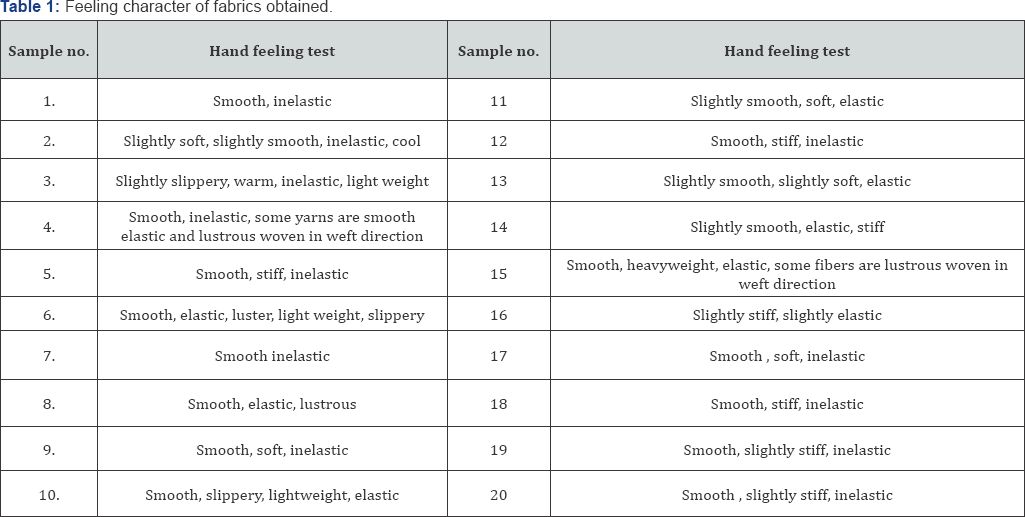
This result is obtained by gentle handling of the two
sides of the fabric surfaces. The fabrics we have tested have different
smoothness, softness, stiffness and elasticity but this depends also on
the finishing technique given to the fabric and its construction. The
handling sensation of each fabric is in the Table 1 below.
Burning nature
When we bring to flame, all most all the fabrics
shrinks and then burn giving yellow orange flame with different odors.
During burning some fibers distinguish themselves and others extinguish
in the opposite manner. In this method we have identified fabrics
containing cotton or wool blended with other fabrics depending on their
odour, self-extinguish ability and residues obtained Table 2.
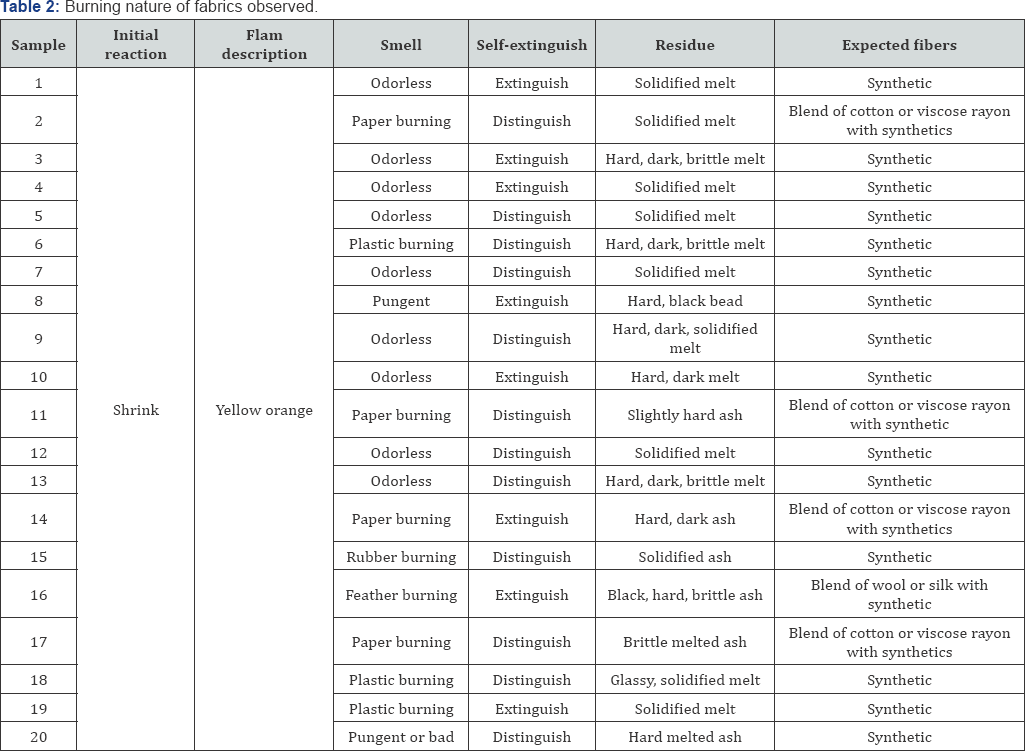
Longitudinal viewed appearances
Different longitudinal views were obtained even in
one fabric. Some fibers with rod like or circular straight longitudinal
appearance, some fibers have fewer margins, and some fibers have fewer
convolutions and combination of the above. There are also fibers of
thin, thick or blend of these in one fabric. Standing from their
structure i.e. presence of convolutions, scale margins and regular rod
like structure we have identified cotton, wool and synthetic fibers as
show below in Table 3.
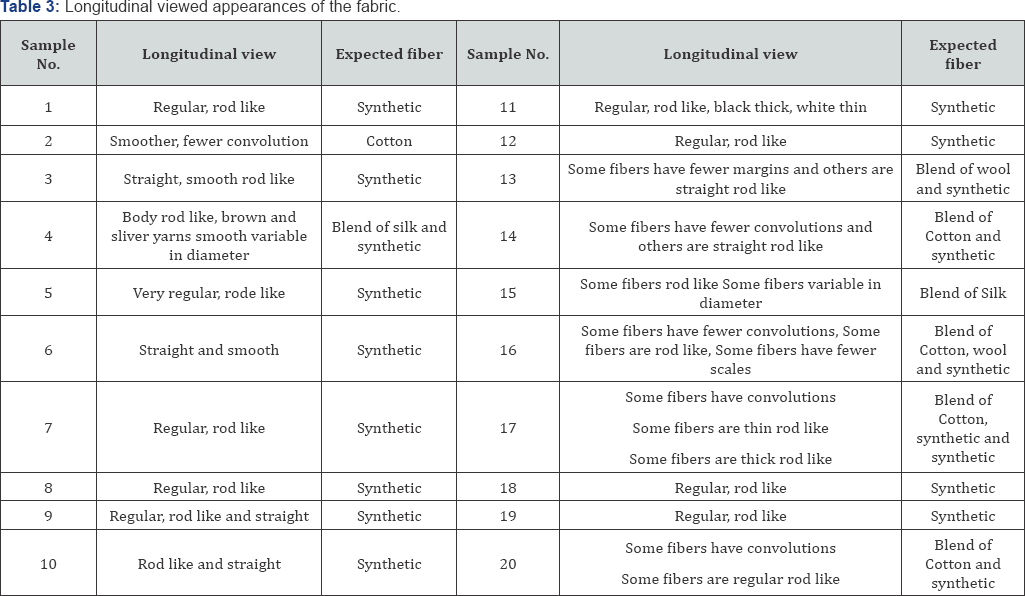
Solubility
By feeling, burning and microscope test we identified
natural fibers from synthetic fibers and cellulosic fibers (cotton)
from protein fibers (wool and silk). Within solubility test we have
indicated each definite groups and specific fibers.
By this method we have obtained two forms of blend fabrics i.e. blending takes place at;
a. Yarn stage: the blend takes place at spinning stage. So, the fabrics have a blended yarn along weft and warp direction.
b. Fabric stage: this type of bled is takes place at
weaving stage i.e. the weft and warp yarns are made from different
fibers or the weft and warp yarns have different constituents of fibers Table 4.
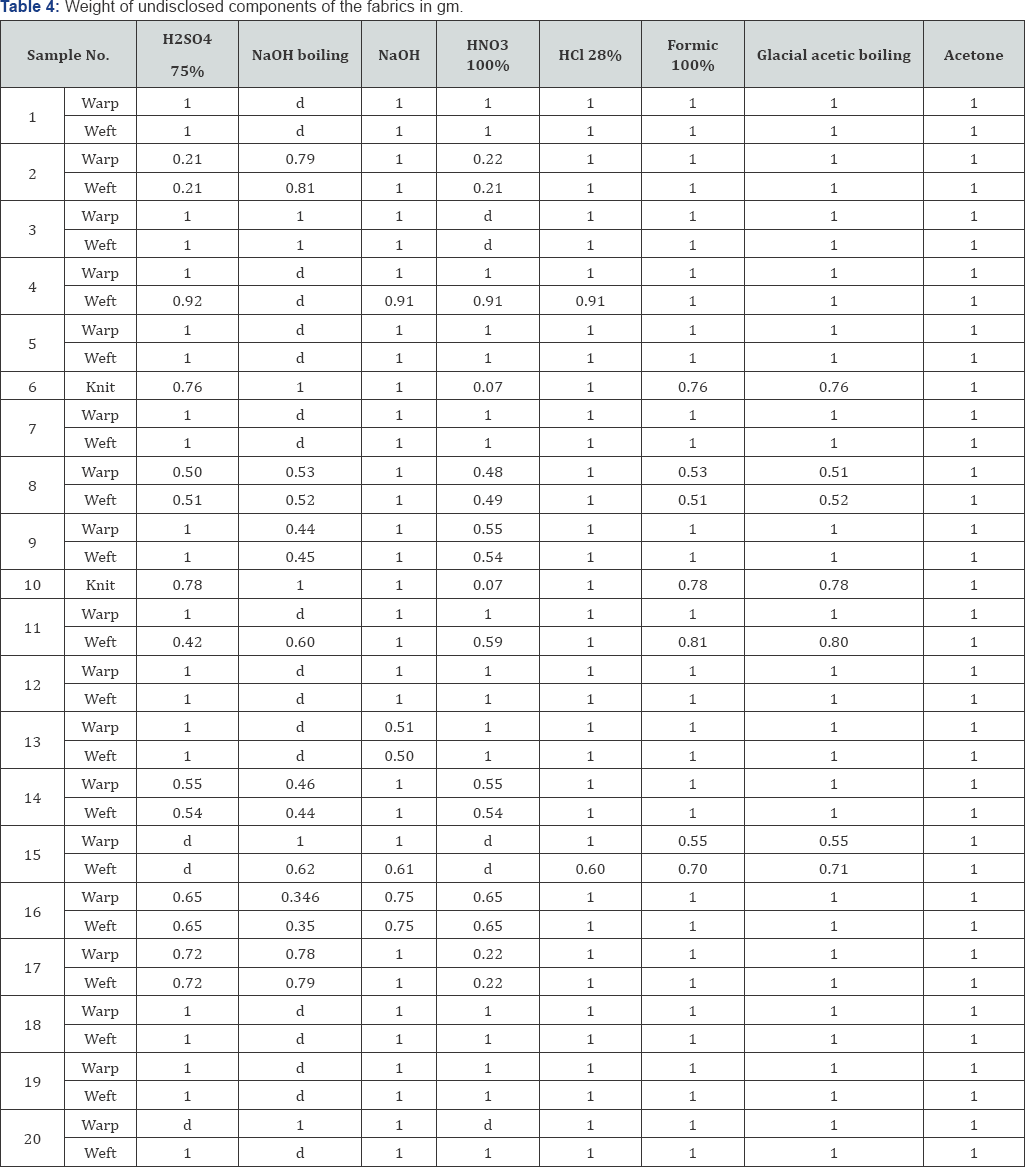
Qualitative Components

Qualitative component of the fabric is content of the
fabric i.e., the fabric from what type of fiber is made which is
represented by word without definite amount of contents of the fibers.
The result we have obtained is below in the Table 5.
Quantitative component (blend ratio analysis by Calculation)
Quantitative component is defined as way of
expressing the composition of fibers found in unknown fabric by
numerical percentage. Then as we have done in this project the fabrics
have different types of fibers and composition percents.
 Where,
M1=Mass of the dried insoluble fibers, M=Mass of the dried initial
specimen, C1=Blend ratio of the dried insoluble fibers (%), 100-C1=Blend
ratio of the dissolved fiber (%).
Where,
M1=Mass of the dried insoluble fibers, M=Mass of the dried initial
specimen, C1=Blend ratio of the dried insoluble fibers (%), 100-C1=Blend
ratio of the dissolved fiber (%).Formula for calculation of quantitative components
PPC = picks per centimeter i.e. number of yarns in weft direction
EPC = ends per centimeter i.e. number of yarns in warp direction
A = Weight of one warp in mg, B = Weight of one weft in mg
K1 = percentage value of first warp fibers, L1 = percentage value of second warp fibers
K2 = percentage value of first weft fibers, L2 = percentage value of second weft fiber
M = percentage value of third weft fibers
Since there are PPC numbers of weft yarns in one centimeter and EPC number warp yarns in one centimeter, then:
Weft/cm in mg = PPC * B = PB and
Warp/cm in mg = EPC * A = EA
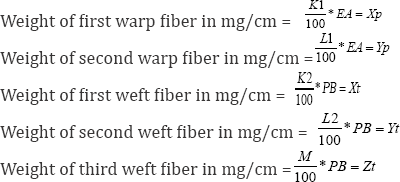
Quantitative component or blend ratio of the first fiber =
 Quantitative component or blend ratio of the second fiber
Quantitative component or blend ratio of the second fiber  Quantitative component or blend ratio of the third fiber =
Quantitative component or blend ratio of the third fiber = 
 Quantitative component or blend ratio of the second fiber
Quantitative component or blend ratio of the second fiber  Quantitative component or blend ratio of the third fiber =
Quantitative component or blend ratio of the third fiber = 
Therefore the fabric is a blend of Q%, R% and S% of first, second and third fiber respectively.
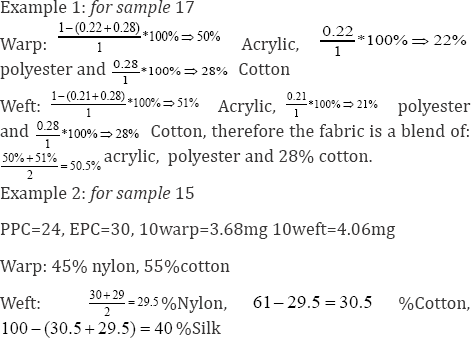
Since there are 24 weft yarns and 30 warp yarns in one centimeter, then the fabric has
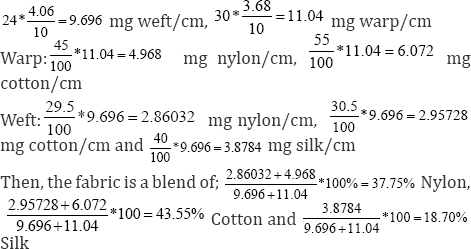
With similar manner to these examples calculating the quantitative components of each fabric the following results obtained Table 6.
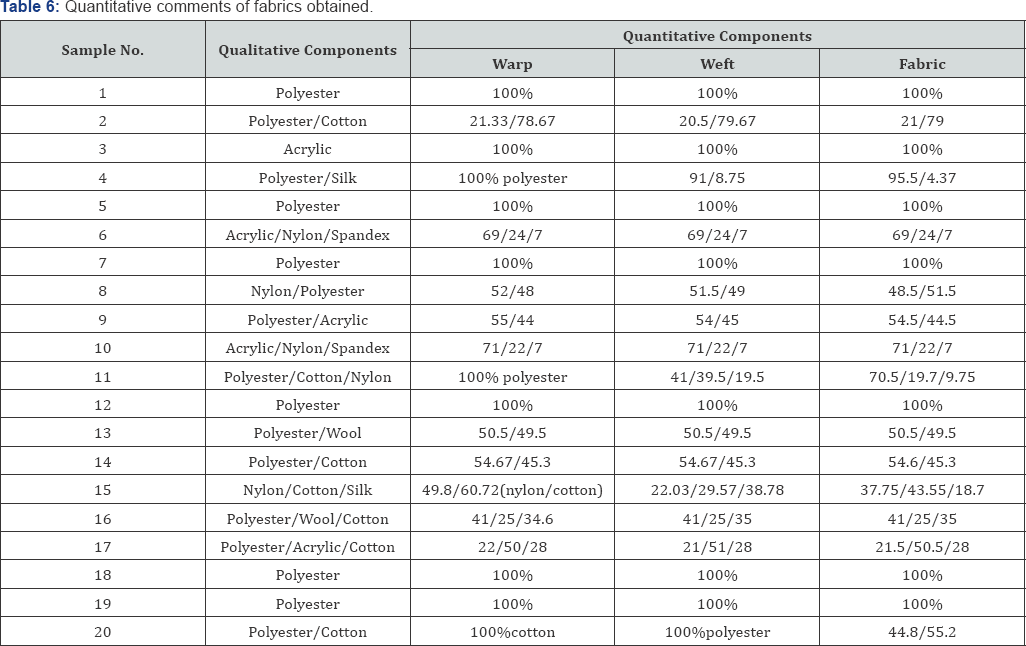
The discussion goes to identify any fabric or to
analyze its percentage it should be in the sequence of feeling, burning,
microscopic and finally solubility. By feeling characteristic
estimation of the fabric whether it is made up of natural or synthetic
fiber is possible and then by burning it is possible to distinguish in
to definite groups i.e. possibility to identify Protein from cellulosic
fibers and these from synthetic fibers. Following by microscope viewing
some specific fibers are identified, like cotton and wool from any
fiber. Finally solubility test will give definite specific fibers and
blend ratio for blended fabrics, by this method any fiber is identified.
Considering the market phenomena with respect to the
cost, serviceability and demand of the fabrics, sample 13, 16 and 2 are
costly, serviceable and highly demanded fabrics for ladies who keep
their cultural dressing, religious dressing and their protocols.
Sample 1, 3, 4, 6, 7, 9, 10, 13, and 18 are cost
effectives, good serviceable and highly demanded fabrics. The rest are
cost effectives (very cheap), serviceable but they are not preferred by
the ladies though they bought to reduce their expense. This is due to
the weight and component of the fabrics which hare obstacle for comfort.
Sample 5 and 14 are stiff though they are serviceable and cost
effective this leads to discomfort. Thus in our country light weight,
soft fabrics are preferable due to the higher temperature condition. The
fabrics dyes were striped with Acids, alkalis and reducing agents like
acetic acid 5% at boiling, hydrosulphite (5%) with sodium hydroxide
(1%)at boiling, pyridine, 1% ammonia at boiling, ammonia and
hydrosulphite and combination of these, but it could not stripped. this
is may be due to the final finishing given to the fabrics.
Identification of textile materials [3-5]
says dyes can be striped using reducing agents like hydrosulphite (5%)
with sodium hydroxide (1%), pyridine, acetic acid, ammonia, ammonia and
hydrosulphite giving for specific types of dyes [6].
Pyridine used to remove disperse and direct dyes, 5% boiling Acetic
acid use to stripe basic dyes from wool and silk,1% boiling Ammonia to
remove acid dyes from silk and wool, sodium hypochlorite for any dye,
and boiling sodium hydro-sulfite (5%)+ Sodium hydroxide (1%) for any
dye.
Conclusion
Fibers can be identifying at fiber stag, yarn stage,
before dying, before garment formation during marketing. To perform
these identifications, the physical (strength, longitudinal and
cross-sectional appearance, handle, absorbency, elasticity drapability
etc.,) and chemical properties (resistant to alkalis, acids and other
specific chemicals, dye affinity, burning nature etc.) of the fibers
being studying is important.
Now days so many similar chemical composition, textured, dyed and finishing agent are given fibers are producing [7].
These fibers are converted to fabrics in single component or combing
two or more fibers. This combining system is called blending and the
produced fabric is called bled fabric. Fibers are blended to obtain
combed property, to reduce cost of expensive fibers and to fid
decorative color effect of garments in coloration during fiber, yarn
formation and fabric formation. Single or blended fabrics can be
identified and analyzed by feeling, burning, microscope test, solubility
staining, density etc.
Non-technical technical (feeling and burning) and
technical (microscopic longitudinal appearance and solubility) tests are
used to identify twenty different fabrics of ladies skirt, which are
mostly wear by Ethiopian ladies and then we have calculated the
qualitative and quantitative components of all the fibers [8].
From the result most of Ethiopian ladies skirt
fabrics are made of synthetic fibers like polyester, acrylic and nylon
and a blend of these fibers with wool and cotton. This shows these kinds
of fabrics are imported to satisfy the demand of the customers.
The Ethiopian textile industries have to produce
polyester, nylon and acrylic fibers and blend of these with natural
fibers like cotton and wool in enough quantity for the future, since
fabrics made of these fibers are cost effective, good serviceable and
highly demanded by the Ethiopian ladies. If these fabrics will produced
there will be additional advantage to our country since market will be
in local exchange for both the customer and country's economy
To know more about Journal of Fashion technology : https://juniperpublishers.com/ctftte/index.php
To know more about open access journals Publishers click on Juniper Publishers




Comments
Post a Comment